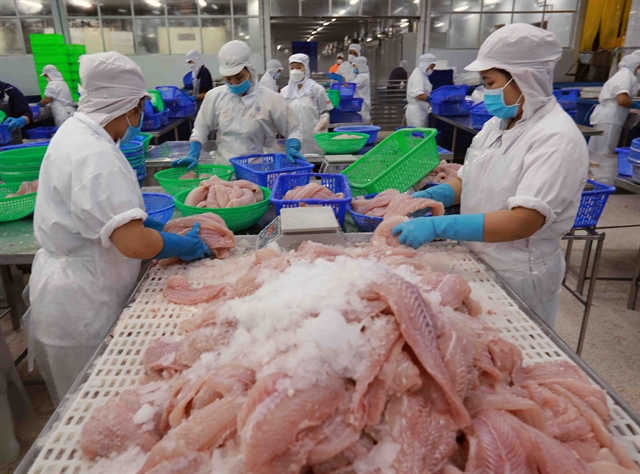 Economy
Economy

 |
| A tra fish processing plant in Đồng Tháp Province. — VNA/VNS Photo |
HÀ NỘI — Facing headwinds in export markets, seafood producers are increasingly looking inward, with the domestic market seen as a strategic way to stabilise production, maintain supply chains and reduce reliance on fluctuating international demand.
Vietnamese seafood has built a strong foothold abroad, reaching more than 170 countries and territories worldwide. Yet many companies still encounter challenges when seeking to expand again at home, despite a promising market of more than 100 million consumers and rising demand.
Experts say higher incomes in Việt Nam are reshaping food preferences, including stronger appetite for seafood. Domestic consumers are paying greater attention to product quality, food safety and traceability, creating opportunities for firms already producing high-standard export goods to serve local customers with internationally certified products.
After more than 20 years partnering with Saigon Co.op, Hoàng Văn Thế, sales director of Saigon Food Joint Stock Company, said Saigon Co.op had become the company’s biggest distribution channel. Sales through the retail network accounted for around 30 per cent of Saigon Food’s domestic revenue, helping stabilise performance when exports face obstacles, he said.
However, not all firms could successfully enter modern retail chains. Despite strong reputations and production capacity, many seafood businesses still struggled to compete in the home market.
One factor, Thế noted, was inconsistent transparency in product quality across domestic distribution systems. High-quality products with international certification often lost out to lower-priced goods from smaller producers using less strictly controlled materials.
Lê Hằng, Vice Secretary-General of the Vietnam Association of Seafood Exporters and Producers (VASEP), said this was partly rooted in corporate mindset and strategy. Many seafood firms remained export-focused and had not given sufficient attention to domestic consumers, she said.
Efforts in media outreach, brand building and storytelling remained limited, Hằng added. Approaches to the home market were still largely traditional, without fully exploiting modern retail channels, particularly e-commerce.
According to VASEP, only around 20–25 per cent of seafood firms participate in e-commerce in a systematic way.
On the consumer side, habits and awareness still vary widely, especially in rural regions. Many buyers continue to prioritise fresh products without recognising the value of deep-frozen seafood that is rigorously checked for antibiotic residues and food safety.
According to senior advisor at Vietnam Fisheries Corporation Joint Stock Company Đặng Hữu Kiên, Việt Nam produces about 4 million tonnes of seafood annually, with 52 per cent frozen for processing factories and the remainder consumed domestically. Of about 5 million tonnes of farmed seafood, around 70 per cent is processed for export and the rest sold to local buyers.
Domestic consumption largely follows a spontaneous and traditional model, lacking structured links between supply and demand. Trade promotion activities, exhibitions and fairs organised by ministries and sectors have yet to produce sustained results.
Other difficulties include uneven regional production and processing, especially between the South, where output is concentrated, and the North, which has stronger consumption demand. Purchasing power in supermarkets also remains below potential.
To better unlock the home market, Hằng called for closer co-ordination between businesses and regulators, particularly the Ministry of Industry and Trade, to develop a professional and synchronised supply chain. Reducing pressure for unreasonable discounts, improving cold logistics and standardising co-operation processes would ease business operations, she said. Product trials and showcases at fairs, supermarkets and hotels could also help bring processed seafood closer to consumers.
E-commerce platforms such as Shopee, TikTok Shop and Zalo OA should be better leveraged to expand market reach, she added.
Kiên said a more comprehensive ecosystem linking producers, processors, distributors and consumers was needed. Multilateral co-operation among regulators, businesses, farmers and fishermen would gradually address fragmentation and raise the added value of Vietnamese seafood in the domestic market.
Việt Nam’s seafood exports reached US$9.31 billion in the first 10 months of this year. Shrimp led with $3.89 billion, up 21.6 per cent, boosted by stable demand from the US, Japan and the EU. Tra fish followed with $1.66 billion, up 7.5 per cent on stronger demand from China, the US and the Middle East.
VASEP said the strong performance reflected both recovery and adaptability among Vietnamese firms amid global uncertainty. Many companies had diversified markets, strengthened processing and prioritised quality to meet international standards.
However, anti-dumping and countervailing duties in the US, strict MMPA fishing rules and the EU’s unresolved yellow card on illegal, unreported and unregulated fishing continued to weigh on exporters, alongside increasing competition from India, Thailand and Indonesia.
Experts urged firms to monitor market developments, adjust strategies to tap ASEAN, the Middle East and niche markets, and invest in processing, technology and branding to reinforce long-term competitiveness. — VNS

.jpg)
.jpg)

